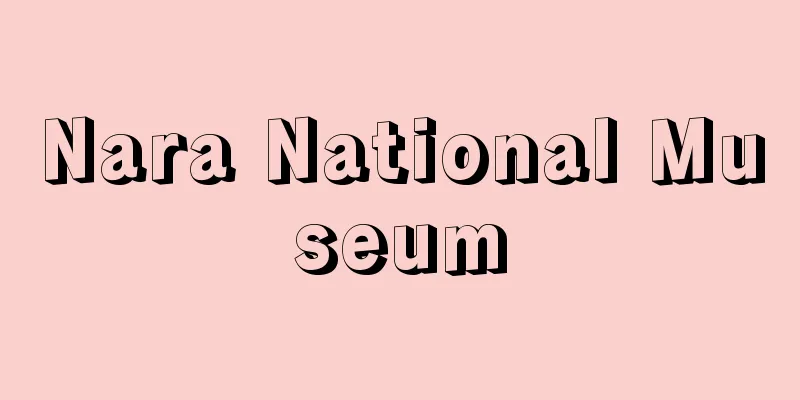Nara National Museum

|
A museum located in Noborioji-cho, Nara City. Its predecessor was the Imperial Museum of Nara, which was founded in 1889 (Meiji 22). In 1894, the building designed by Katayama Tokuma (the current Nara Buddhist Statue Hall, an Important Cultural Property) was completed, and it opened the following year in 1895. In 1900 (Meiji 33), the museum was renamed the Imperial Household Museum of Nara due to a government reform. It was subsequently managed and operated by the Imperial Household Ministry, and in 1947 (Showa 22), it came under the jurisdiction of the Ministry of Education and was renamed the Nara Branch of the National Museum. In 1950, following the amendment of the Law for the Protection of Cultural Properties, it became an affiliated institution of the said committee, and in 1952, it became independent as the Nara National Museum, and came under the jurisdiction of the Agency for Cultural Affairs when it was established in 1968. It then became an independent administrative institution, the National Museum, in April 2001, and an independent administrative institution, the National Institutes for Cultural Heritage, in April 2007. The exhibition hall is divided into the Nara Buddhist Statue Gallery (old main building), the Bronzeware Gallery, the New East Wing, and the New West Wing. Works of Buddhist art are systematically exhibited from the Asuka period onwards, and display cases are set up in the underground passageway connecting the two buildings, where photo panels of various themes are displayed to help visitors gain a basic understanding of Buddhist sculpture, making it a distinctive museum specializing in Buddhist art. There is also the Buddhist Art Materials Research Center, which makes Buddhist art-related materials available to researchers and others. There are permanent exhibitions, special exhibitions, and small-scale planned exhibitions, and the Shosoin Treasures Exhibition, held every autumn, is particularly famous. The museum's collection includes over 1,800 items, including national treasures and important cultural properties, as well as sculptures, paintings, crafts, calligraphy, and archaeological materials entrusted to it by shrines and temples in Nara and around the country. The museum is also actively engaged in research, lectures, lectures, and publications on Buddhist art, with a focus on exhibitions. The museum is closed every Monday (or the following day if Monday is a holiday) and over the New Year holidays. [Shinichi Nagai January 19, 2017] "The History of Shosoin - Thirty Years of the Shosoin Exhibition at the Nara National Museum" (1977)" ▽ "The Catalogue of Masterpieces at the Nara National Museum" Popular Edition (1980, Dohosha Publishing)" ▽ " The Catalogue of Plates in the Nara National Museum Collection - Paintings", "The Catalogue of Plates in the Nara National Museum Collection - Sculptures", "The Catalogue of Plates in the Nara National Museum Collection - Calligraphy" (1988, 89, 90)" ▽ "The Centenary History of the Nara National Museum" (1995)" ▽ "Weekly Asahi Encyclopedia: Japan's 50 National Treasures" (1998, Asahi Shimbun)" ▽ "Weekly Art Museums of the World 93: Nara National Museum" (2001, Kodansha)" ▽ "The Deer Garden Collection" (2002, Kodansha Publishing)" Nara National Museum Research Bulletin” Annual Editions” [References] | | | | |Former Imperial Museum of Nara (Nationally designated Important Cultural Property). Nara City, Nara Prefecture © Nara City Tourism Association "> Nara National Museum Source: Shogakukan Encyclopedia Nipponica About Encyclopedia Nipponica Information | Legend |
|
奈良市登大路(のぼりおおじ)町にある博物館。前身は帝国奈良博物館で、1889年(明治22)に設立され、1894年片山東熊(とうくま)設計の建物(現在のなら仏像館、重文)が完成、翌1895年開館した。1900年(明治33)官制改(あらため)により奈良帝室博物館と改称。その後、宮内省が管理運営にあたり、1947年(昭和22)文部省所管となって国立博物館奈良分館と改められ、1950年の文化財保護法の改正に伴い同委員会の付属機関となり、1952年奈良国立博物館として独立、1968年の文化庁の発足と同時にその管轄となった。さらに2001年(平成13)4月より独立行政法人国立博物館、2007年4月から独立行政法人国立文化財機構の一組織となった。 陳列館は、なら仏像館(旧本館)、青銅器館、東新館、西新館に分かれ、仏教美術の諸作品を飛鳥(あすか)時代から体系的に展示し、両館を結ぶ地下連絡路に陳列ケースを設け、仏教彫刻の基本的理解に資するため、各種のテーマを写真パネルにして展示、仏教美術の専門館として特色を発揮している。ほかに仏教美術関連資料を研究者などに公開する仏教美術資料研究センターがある。展観は常設展、特別展、それに小規模の企画展などがあり、とくに毎年秋に開催される正倉院の宝物展観は有名。収蔵品は館所蔵で国宝・重要文化財を含む1800点余、ほかに奈良をはじめ全国の社寺から寄託された彫刻・絵画・工芸・書・考古資料など多数あり、展観を中心に仏教美術の調査研究・講座・講演・出版などにも意欲的な活動を行っている。休館日は毎週月曜(休日の場合翌日)と年末年始。 [永井信一 2017年1月19日] 『奈良国立博物館編・刊『正倉院の歴史――奈良国立博物館正倉院展三十年のあゆみ』(1977)』▽『奈良国立博物館編『奈良国立博物館名品図録』普及版(1980・同朋舎出版)』▽『奈良国立博物館編・刊『奈良国立博物館蔵品図版目録 絵画篇』『奈良国立博物館蔵品図版目録 彫刻篇』『奈良国立博物館蔵品図版目録 書跡篇』(1988、89、90)』▽『奈良国立博物館編・刊『奈良国立博物館百年の歩み』(1995)』▽『『週刊朝日百科 日本の国宝50』(1998・朝日新聞社)』▽『『週刊世界の美術館93 奈良国立博物館』(2001・講談社)』▽『奈良国立博物館編・刊『鹿園雑集 奈良国立博物館研究紀要』各年版』 [参照項目] | | | | |旧帝国奈良博物館本館(国指定重要文化財)。奈良県奈良市©奈良市観光協会"> 奈良国立博物館 出典 小学館 日本大百科全書(ニッポニカ)日本大百科全書(ニッポニカ)について 情報 | 凡例 |
Recommend
Phasmida
...They live on food trees. The order Cheleutopte...
Gray clay
⇒Podzol Source: About Shogakukan Digital Daijisen ...
Treaty on the Non-Proliferation of Nuclear Weapons
Officially, it is the Treaty on the Non-Prolifera...
Implicit function
Given an equation, for example x 2 +y 2 =1, if yo...
Aspasma minima (English spelling)
...Some species can reach a length of 30 cm, some...
intergovernmental relations
...An organization created by private individuals...
Ascension [island] - Ascension
An isolated island of volcanic origin in the centr...
Frozen food - Reitoushokuhin (English spelling) frozen food
This refers to food that has been frozen to give ...
Baseline surveying
A distance measurement in which the length of the ...
《Chair》 - Chair
In 1948, he wrote La cantatrice chauve (1950), a ...
Perino del Vaga (English spelling) PerinodelVaga
… [The birth of Mannerism] Regarding the origins ...
Noon - Shogo
〘Noun〙 Twelve o'clock in the day. The time whe...
Tanganyika
…Official name: United Republic of TanzaniaArea: ...
Mount Uji
A mountain in the southeastern part of Uji City, K...
Roundworm (Ascaris) - Roundworm
A parasitic worm belonging to the nematode family ...









